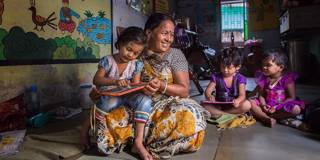Since the start of the pandemic, the world’s wealthiest countries have sought to strengthen their domestic childcare infrastructure and broaden access. But if these countries truly want to improve the economic outlook for women globally, they must invest in childcare programs abroad, too.
WASHINGTON, DC – When COVID-19 lockdowns began, the importance of affordable childcare suddenly became a lot clearer to many more people, especially working women. Last year, women spent three times as many hours as men providing additional unpaid childcare, losing an estimated $800 billion in income as a result. The gender gap in childcare provision is even wider in low- and middle-income countries. In India, for example, women provided ten times as much unpaid childcare as men.
Since the start of the pandemic, the world’s wealthiest countries have sought to strengthen their domestic childcare infrastructure and broaden access. But if these countries truly want to improve the economic outlook for women globally, they must invest in childcare programs abroad, too.
Even before the pandemic, quality childcare was widely accessible in many high-income countries. Canada gives families sizable monthly allowances to subsidize the cost. Iceland provides universal preschool, and Denmark allows new parents to shorten their work hours while keeping their jobs, salaries, health care, and other benefits. Swedish parents are entitled to a combined 480 days of leave at around 80% pay, which can be used at any point until their child’s eighth birthday.

WASHINGTON, DC – When COVID-19 lockdowns began, the importance of affordable childcare suddenly became a lot clearer to many more people, especially working women. Last year, women spent three times as many hours as men providing additional unpaid childcare, losing an estimated $800 billion in income as a result. The gender gap in childcare provision is even wider in low- and middle-income countries. In India, for example, women provided ten times as much unpaid childcare as men.
Since the start of the pandemic, the world’s wealthiest countries have sought to strengthen their domestic childcare infrastructure and broaden access. But if these countries truly want to improve the economic outlook for women globally, they must invest in childcare programs abroad, too.
Even before the pandemic, quality childcare was widely accessible in many high-income countries. Canada gives families sizable monthly allowances to subsidize the cost. Iceland provides universal preschool, and Denmark allows new parents to shorten their work hours while keeping their jobs, salaries, health care, and other benefits. Swedish parents are entitled to a combined 480 days of leave at around 80% pay, which can be used at any point until their child’s eighth birthday.